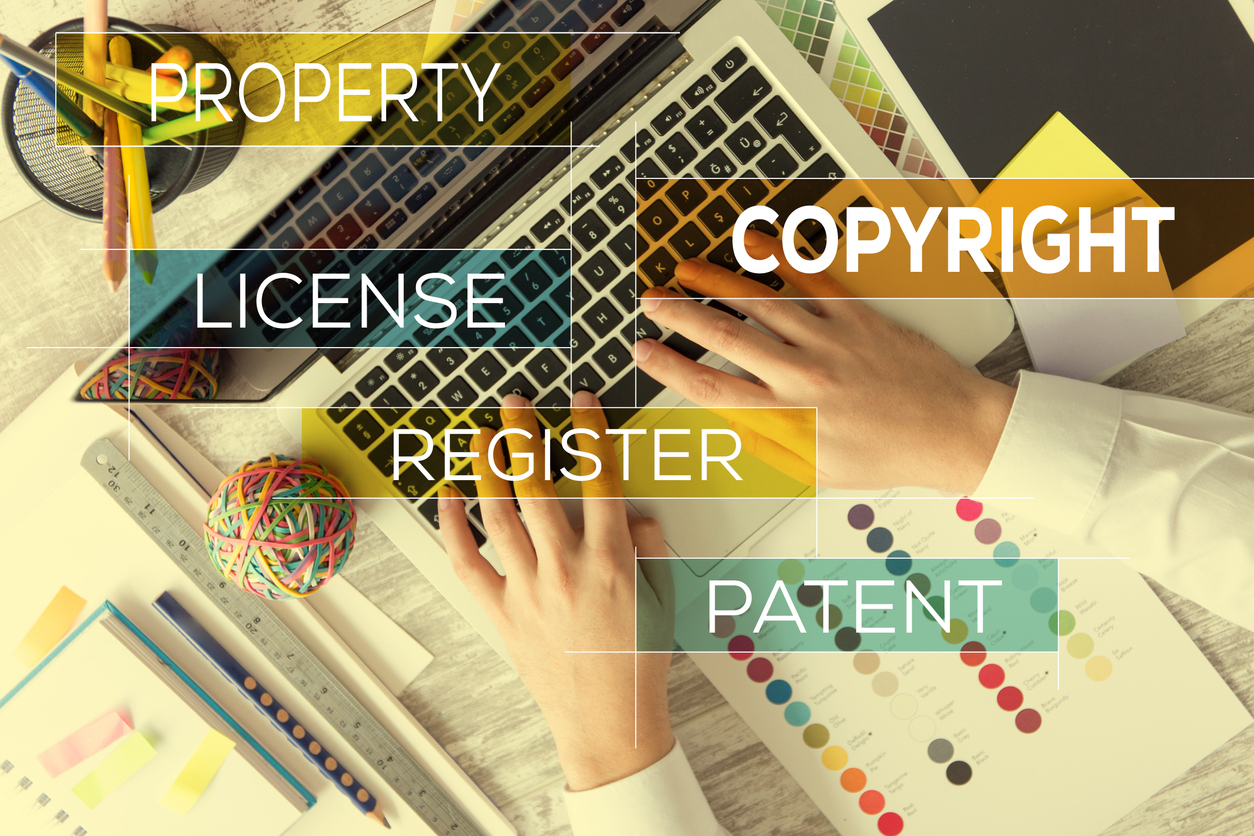We are pleased to announce our Spring 2024 interns at A&BC! Our internship program is…

Patent Basics for Independent Entrepreneurs
Patents, Trademarks, Copyrights, and Trade Secrets
Patents, trademarks, copyrights, and trade secrets are all forms of protection for intellectual property but they all protect different forms of ideas. It can be a bit confusing figuring out which category your idea falls into, and hopefully reading this will help you decide which one best fits your idea.
Trademarks protect brands. Trademarks and service marks (for companies offering services rather than products) protect words, short phrases, or images that are associated with a business, product, or service. Trademarks can be registered with the U.S. Patent and Trademark Office (“USPTO”) but can also receive some protection under the law without being registered. The Nike “swoosh,” the name Nike, and the phrase “Air Jordan,” are all trademarks of Nike, Inc. Trademarks communicate the quality of a product to purchasers and potential purchasers.
Copyrights protect creative expressions fixed in a tangible medium. Copyrights are suitable for creative works rather than useful works, like inventions. Books, songs, and photographs are common forms of copyrightable material. Copyrights do not have to be registered to give rights to the copyright holder but must be registered to allow the holder of the copyright to file a claim in court to enforce their rights.
A trade secret is a design, formula, process, or other piece of IP that is not known to the general public and provides businesses with an economic advantage over others. Trade secret protection is weaker than the other IP protections offered under the law, but there is no time limit to how long a trade secret can be protected. It also allows businesses to keep information secret without the required disclosures called for by patent law. A good example of a trade secret is the recipe for Coca-Cola. Because recipes are not patentable, the makers of Coke have kept the recipe a secret so that others cannot copy it. Additionally, it gives them the benefit of protection for as long as they keep it secret, which could be forever. Trade secrets do not protect from reverse engineering. If you have a product commercially available that is protected under trade secret, someone can still reverse engineer the product, figure out how it was made, and then start reproducing it themselves. So, if someone were to figure out the recipe for Coke, Coca-Cola would not be able to sue because trade secret protection does not cover reverse engineering. It would, however, protect Coca-Cola from a disgruntled employee spilling the secret recipe to his friend.
Utility patents protect inventions. This is what the Patent Pro Bono Program is meant to help with. Patents protect processes, machines, manufactured items, or compositions of matters if they meet certain criteria discussed below. Patents offer protection for 20 years, after which the information is available for public use.
There are also design patents for ornamental elements that exist separately from the functional aspect of a product. An example of something that is covered by a few design patents is the iPhone’s face (where the home button is, the iOS of the screen, etc.). The Patent Pro Bono Program does not extend to these filings though, it only covers utility patents.
Patentability
There are several criteria an idea must meet to be eligible for a patent. The idea must be novel, useful, and non-obvious and it must fit within the statutory subject matter eligibility requirement. If an idea does not meet any of these requirements, the USPTO will not issue a patent. If the idea is not patentable, it still may be eligible for other types of protection. You may want to discuss with your lawyer what kind of IP protection would be best suited to your idea.
- Subject Matter Eligibility
To be eligible subject matter, the invention must be a “useful process, machine, manufacture, or composition of matter.”[i] Most physical inventions will meet the subject matter eligibility prong, but there is a lot of gray area regarding patents for non-physical inventions.
- Usefulness
The invention must also be useful. Usefulness is determined by “having a real-world use.”[ii] For most ideas, this is a fairly easy requirement to meet. There can be some difficulty with chemical compounds though, as their usefulness is not always readily apparent.[iii]
- Novelty
The idea must also be novel. This means that the idea has to be new and never patented or publicly disclosed before. To get an idea of whether your patent is novel, you can (and should) complete a prior art search (information on how to perform a basic search is discussed below). “Art” in this sense means previous inventions that have been disclosed to the public. If you or someone else finds that your invention has been disclosed before, you will not be issued a patent. If it is found after the fact, your patent will be considered invalid.
However, this does not necessarily have to be a death sentence for your invention. If you find something very similar, but there is any kind of significant difference (think of a useful difference, not merely cosmetic) from your invention, there is still a chance that your invention could be patented if the difference in your idea meets the next prong – non-obviousness, discussed below. Through your prior art searches, you can get an idea of what has been claimed before and work with your lawyer to craft claims around what has been disclosed before.
- Non-obviousness
The invention must also be non-obvious. A patent will not be issued if “the claimed invention as a whole would have been obvious before the effective filing date of the claimed invention to a person having ordinary skill in the art to which the claimed invention pertains.” So, an idea is obvious if a person of ordinary skill in the art (someone who practices that profession) would have been able to easily make or think of the invention based on the prior art. If your prior art search also turns up something very similar to your invention, then it is at risk of not being patentable. The patentability would depend on how easy it is to get to your idea from the prior art.
These criteria are very difficult to parse and figure out if your idea is patentable – sometimes even lawyers get it wrong. If you’ve read this primer and still think that your idea could qualify for a patent, you should contact the VLA and apply for patent pro bono services (after performing a basic prior art search).
Know Before You Apply: A Note on Software Patents
Software patents are tricky. There are myriad issues with them, including the level of abstraction in most of the patents that exist, making it hard to understand what those patents actually are claiming and whether they can make those claims. Lawyers are hesitant to take on software patent matters because it is hard for them to understand what has been previously claimed and whether what has previously been claimed is even valid. In addition, Software often implements an abstract idea on a computer, but because the underlying idea is abstract, it is not patentable just because it can be performed on a computer. In Alice Corp. v. CLS Bank International, the Supreme Court invalidated patents for an application on a computer that tracked escrow because they just moved the abstract idea of tracking escrow into a software application. If you’re interested in reading more about problems with software patents you can find some more information here.
Prior Art Searches
At VLA, we require you do a basic prior art search to ensure your idea meets the criteria discussed above. Prior art, in the patent context, is previous inventions or ideas that have been published and are publicly known. Doing a prior art search ensures that you have familiarized yourself with the ideas that have already been patented or published, helps explain how your patent is different than other ideas, and will notify you if you need to change your idea before going through the costly and timely patent process just to be rejected (note: while the lawyer’s fees are offered on a pro bono basis through the patent pro bono program, you still have to pay the application fees to the USPTO to apply for your patent). Doing a prior art search takes time, but in the long run, it is extremely useful and may save time later in the patent process.
To do a prior art search you should first brainstorm possible keywords that may be used to describe your invention.[iv] You want your search to be as wide as possible just in case there is something out there that would prevent you from being given a patent.
After you come up with a list of keywords, you will use that list to search patent databases (we have included a list of some at the end of this article). While you don’t have to do a perfect search and find every single prior piece of art, it is important to remember that if anyone finds something out there similar, it could invalidate your patent. This search can seem very overwhelming. To limit the search, save the top ten results for each keyword that you’ve come up with and save all of the patents that are referenced in those patents as prior art.[v] This is called a forward and backward cross-reference search.[vi]
Keyword searches are not perfect: there is still a chance that the USPTO will come up with some prior art that you and your lawyer did not come across before. The USPTO suggests that you do a patent classification search to find patents that are similar to yours. This is an even more time-consuming search method; however, this is the way the USPTO will search for patents to find prior art similar to yours. This search, like the search discussed above, will find patents that are similar to yours, but even an idea that has been “disclosed” before can count as disqualifying prior art.
Because disqualifying prior art is not limited to prior patents, you will also want to search databases like Google Scholar or the product pages of businesses that may be inventing similar things.[vii]
Save everything you come across that seems relevant to your patent.[viii] Think about how you can differentiate your patent from the prior art you’ve found and saved. You can talk to your lawyer to see if there is a way to write claims that highlight the differences of your product to the prior art.
Remember, if you run into any prior art that is the same or very similar (so similar that there is no functional difference), your invention is not patentable. If you do find prior art that would invalidate your patent, and ignore it, it can still invalidate your patent if anyone finds it later, even after you have paid all of the fees.
If you need any help performing a prior art search, you can go to a Patent and Trademark Resource Center.[ix] You can look up the location most convenient to you here: https://www.uspto.gov/learning-and-resources/support-centers/patent-and-trademark-resource-centers-ptrc/ptrc-locations.
Websites to use for Prior Art Searches
https://patents.google.com/ (contains information on patents from several different countries)
http://patft.uspto.gov/netahtml/PTO/search-bool.html (difficult to navigate)
https://worldwide.espacenet.com/
https://patentscope.wipo.int/search/en/search.jsf
https://www.upcounsel.com/prior-art-search
https://www.henrypatentfirm.com/blog/how-to-do-prior-art-search-yourself
Katherine Welch, Esq. is an Attorney at the United States Department of Education and served as a Legal Fellow at the Arts & Business Council of Greater Boston in 2019.
[i] 35 U.S.C. § 101 (2018). [ii] Mueller, Janice M. (2009). Patent Law (3rd ed.). New York: Aspen. p. 236. [iii] Brenner v. Manson, 383 U.S. 519 (1966). [iv] https://www.henrypatentfirm.com/blog/how-to-do-prior-art-search-yourself [v] https://www.henrypatentfirm.com/blog/how-to-do-prior-art-search-yourself [vi] https://www.henrypatentfirm.com/blog/how-to-do-prior-art-search-yourself [vii] https://www.henrypatentfirm.com/blog/how-to-do-prior-art-search-yourself [viii] https://www.henrypatentfirm.com/blog/how-to-do-prior-art-search-yourself [ix] https://www.uspto.gov/learning-and-resources/support-centers/patent-and-trademark-resource-centers-ptrcs


